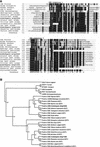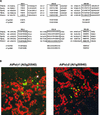Nuclear genes that encode mitochondrial proteins for DNA and RNA metabolism are clustered in the Arabidopsis genome
- PMID: 12837951
- PMCID: PMC165405
- DOI: 10.1105/tpc.010009
Nuclear genes that encode mitochondrial proteins for DNA and RNA metabolism are clustered in the Arabidopsis genome
Abstract
The plant mitochondrial genome is complex in structure, owing to a high degree of recombination activity that subdivides the genome and increases genetic variation. The replication activity of various portions of the mitochondrial genome appears to be nonuniform, providing the plant with an ability to modulate its mitochondrial genotype during development. These and other interesting features of the plant mitochondrial genome suggest that adaptive changes have occurred in DNA maintenance and transmission that will provide insight into unique aspects of plant mitochondrial biology and mitochondrial-chloroplast coevolution. A search in the Arabidopsis genome for genes involved in the regulation of mitochondrial DNA metabolism revealed a region of chromosome III that is unusually rich in genes for mitochondrial DNA and RNA maintenance. An apparently similar genetic linkage was observed in the rice genome. Several of the genes identified within the chromosome III interval appear to target the plastid or to be targeted dually to the mitochondria and the plastid, suggesting that the process of endosymbiosis likely is accompanied by an intimate coevolution of these two organelles for their genome maintenance functions.
Figures




References
-
- Adams, K.L., Daley, D.O., Qiu, Y.-L., Whelan, J., and Palmer, J.D. (2000). Repeated, recent and diverse transfers of a mitochondrial gene to the nucleus in flowering plants. Nature 408, 354–357. - PubMed
-
- Altschul, S.F., Gish, W., Miller, W., Myers, E.W., and Lipman, D.J. (1990). Basic local alignment search tool. J. Mol. Biol. 215, 403–410. - PubMed
Publication types
MeSH terms
Substances
LinkOut - more resources
Full Text Sources
Molecular Biology Databases

